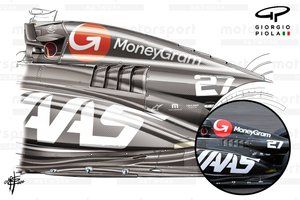The Monaco crane lifts that show how Red Bull and Mercedes's F1 floors compare
Lewis Hamilton's FP3 crash at Formula 1's Monaco Grand Prix gave the whole world a good view of Mercedes's new floor, which provided useful intel on the team's intent.

Photo by: Uncredited
As Hamilton’s Mercedes was lifted into the Monaco skyline following his barrier collision at Mirabeau towards the end of FP3, everyone was treated to a view of the W14’s underfloor, an area of the car that we’re rarely able to catch a glimpse of.
The timing of the incident was especially annoying for Mercedes, whose team boss Toto Wolff called it an act straight out of Cirque du Soleil.
This weekend it debuted a huge raft of changes that the team has made to turns its fortunes around, with the floor being one of them.
Sightings of the underside of the floor have been rare the last couple of seasons, as marshals have diligently lifted stricken cars off the track in a way that makes it awkward for photographers to capture the finer details.
However, the logistical constraints and challenges unique to Monaco's narrow streets have already allowed us to see the Ferrari, Mercedes and Red Bull this weekend, as all three have been lifted clear from the track by nearby cranes.
And, while there’s a clamour to see these images, perhaps it’s the infrequency of their appearance that makes them more appealing than what’s actually to be found when they surface.
Nevertheless, the images do offer small pieces of information in the direction that teams have taken with these new regulations, even if we don’t have a frame of reference from earlier this season.
Comparing the Mercedes floor to the Red Bull, which seems to have one of the most detailed underfloor designs in the field, there appears to be less going on in terms of the surface topology.
In particular, Red Bull has been much more eager to contort the floor and floor strakes to micromanage the airflow’s behaviour and pressure distribution.

Marshals remove the damaged car of Sergio Perez, Red Bull Racing RB19, from the circuit after a crash in Q1
Photo by: Mark Sutton / Motorsport Images
However, Mercedes has definitely made strides when comparing this year’s design to the underfloor of last year's W13. It has taken design cues from its rivals, such as the jagged keel design, rather than using a teardrop-shaped transition into the crash structure, as had previously been the case.
That helps manage the expansion into the diffuser section, with a view to improving flow stability as the car’s ride height changes.
As with any component on the car, the shots captured on Saturday of the underfloor are just a snapshot in time. The entire car is in a constant state of design flux that could be very different at the next event, with the development of last season's underfloors from Red Bull, McLaren and Ferrari a prime example.

Ferrari F1-75 floor development
Photo by: Giorgio Piola
Be part of Motorsport community
Join the conversationShare Or Save This Story
Subscribe and access Motorsport.com with your ad-blocker.
From Formula 1 to MotoGP we report straight from the paddock because we love our sport, just like you. In order to keep delivering our expert journalism, our website uses advertising. Still, we want to give you the opportunity to enjoy an ad-free and tracker-free website and to continue using your adblocker.















Top Comments